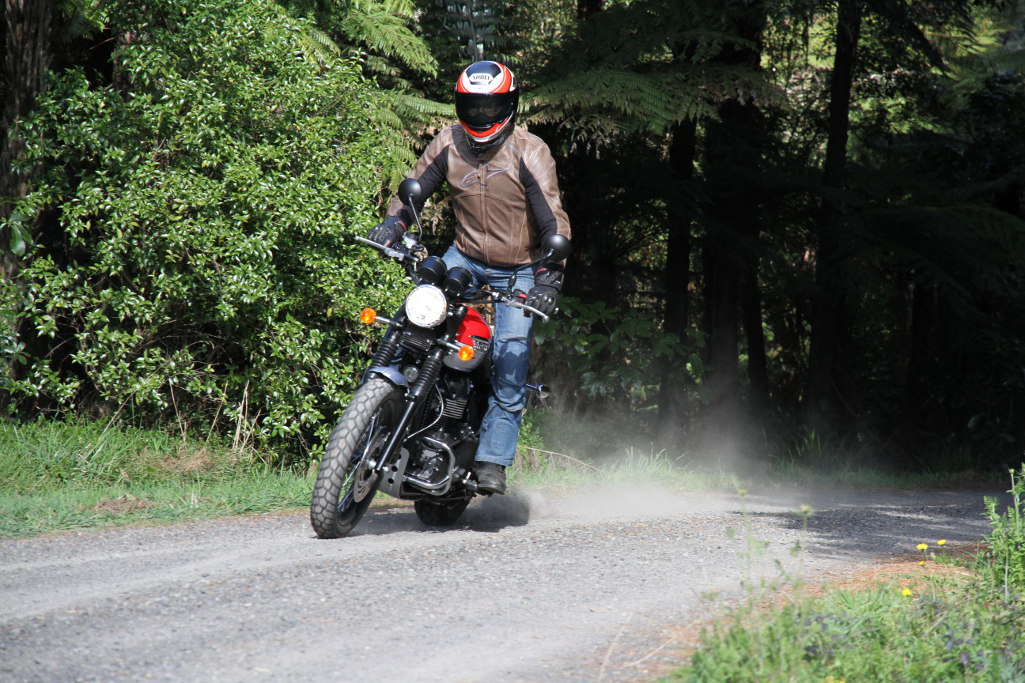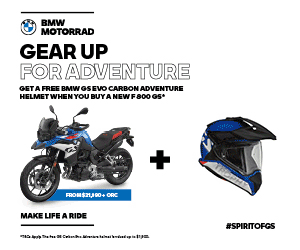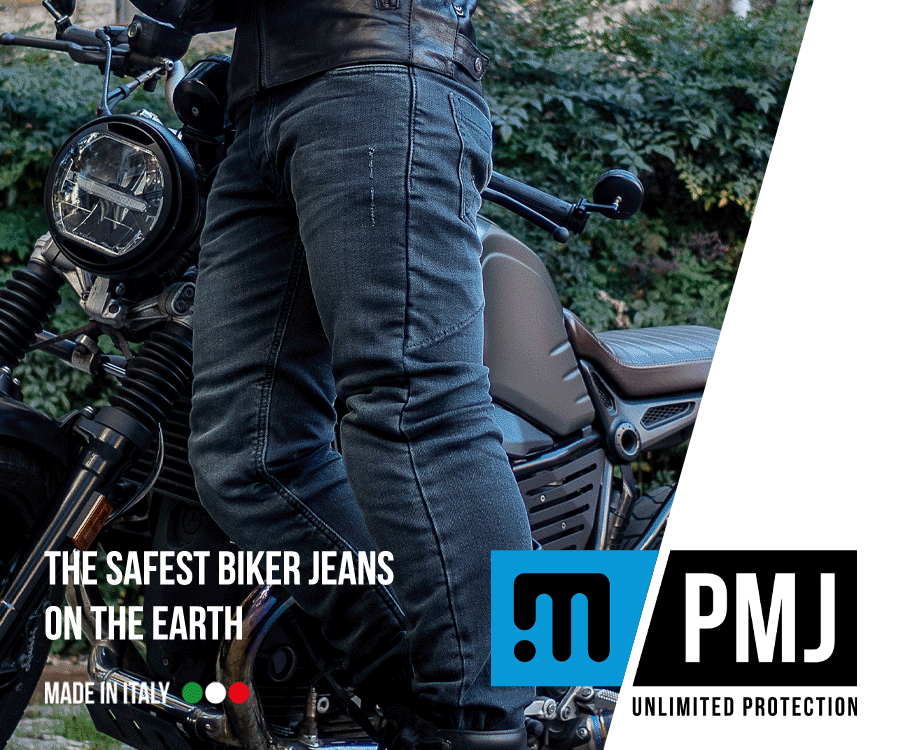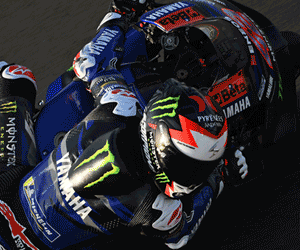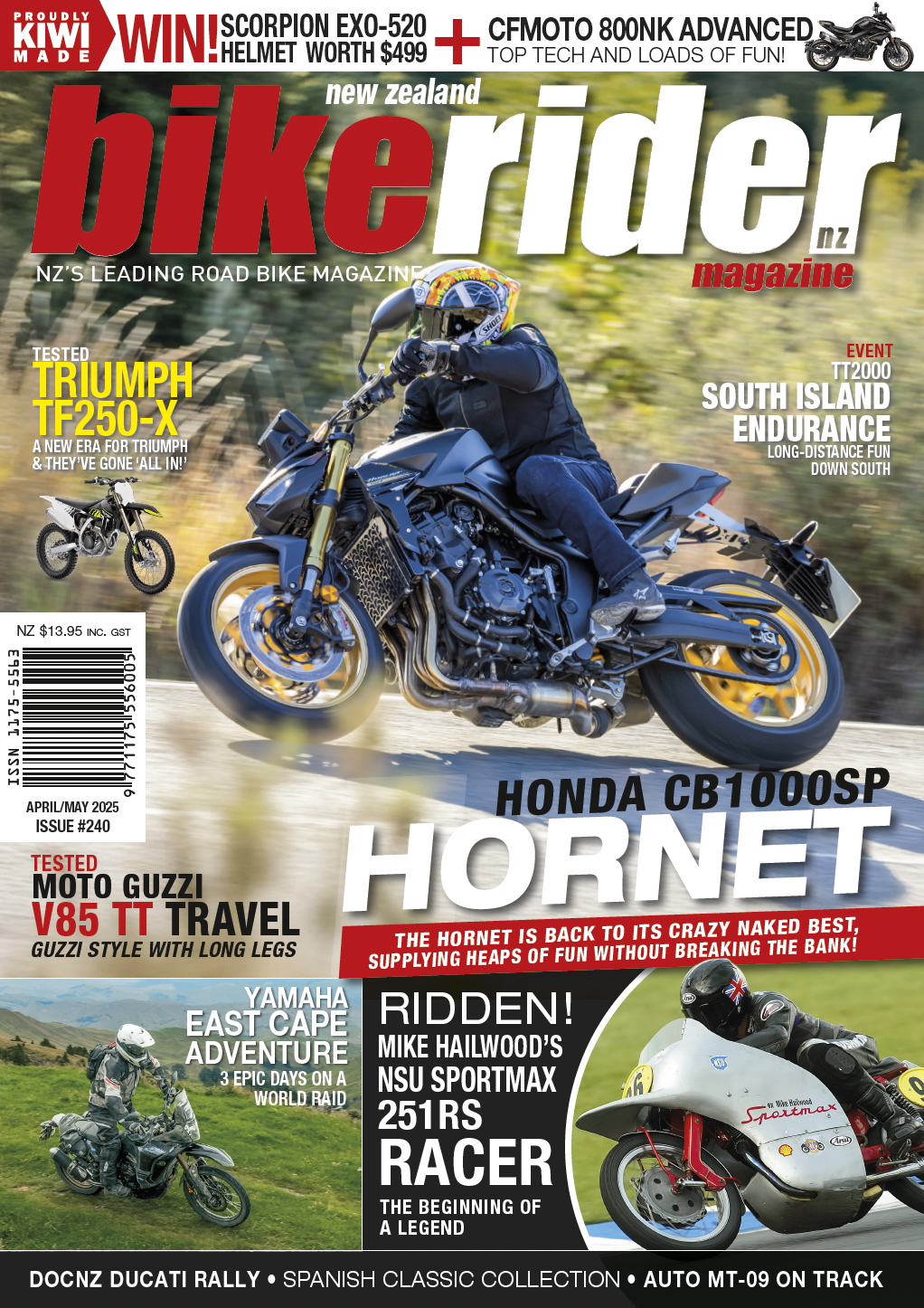Ahem, I was here first… Of the new generation of bikes displaying the Scrambler name on their papers, it was the Triumph Bonneville based machine that was first out of the blocks.
Words: Kev | Photos: Kyle O. Ren
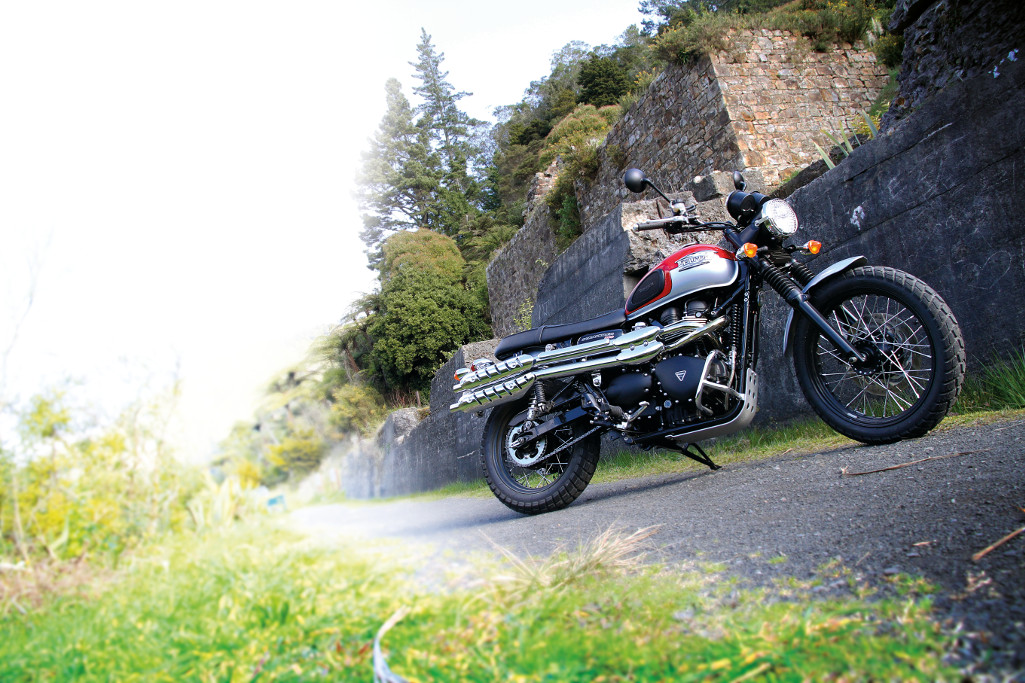 Maybe it was ahead of the times by a couple of years, as the whole retro pseudo off-road theme is now going gang-busters but the quirky Brit really does deserve to be at the forefront of the ‘Hipster Revolution’ – or whatever label you choose to describe the phenomena.
Maybe it was ahead of the times by a couple of years, as the whole retro pseudo off-road theme is now going gang-busters but the quirky Brit really does deserve to be at the forefront of the ‘Hipster Revolution’ – or whatever label you choose to describe the phenomena.
Based less closely on the Bonneville, as well as the unspoken link between the Ducati Monster and their Scrambler, the Trumpy uses a different crankshaft and firing sequence for a unique beat amongst the Bonneville family – despite sharing most other internals. That 270-degree crank gives the Scrambler a unique small-bore American-esque note, for lack of a better way to say it sounds like a cross between the Bonneville and an 883cc Harley when accelerating. That’s helped by the louder pipe it has fitted. The altered firing interval may not boost power but it does let the Scrambler produce 90 per cent of its maximum torque from as low as 2500rpm, peaking at 4750rpm and holding close to that figure until signing off when the horsepower power peaks at 58hp (59PS) when spinning at 7000rpm. Along with the aftermarket exhaust, it was also fitted with the vintage-style headlight protector and the useful-looking alloy bashplate, adding to the rugged outdoorsy image.
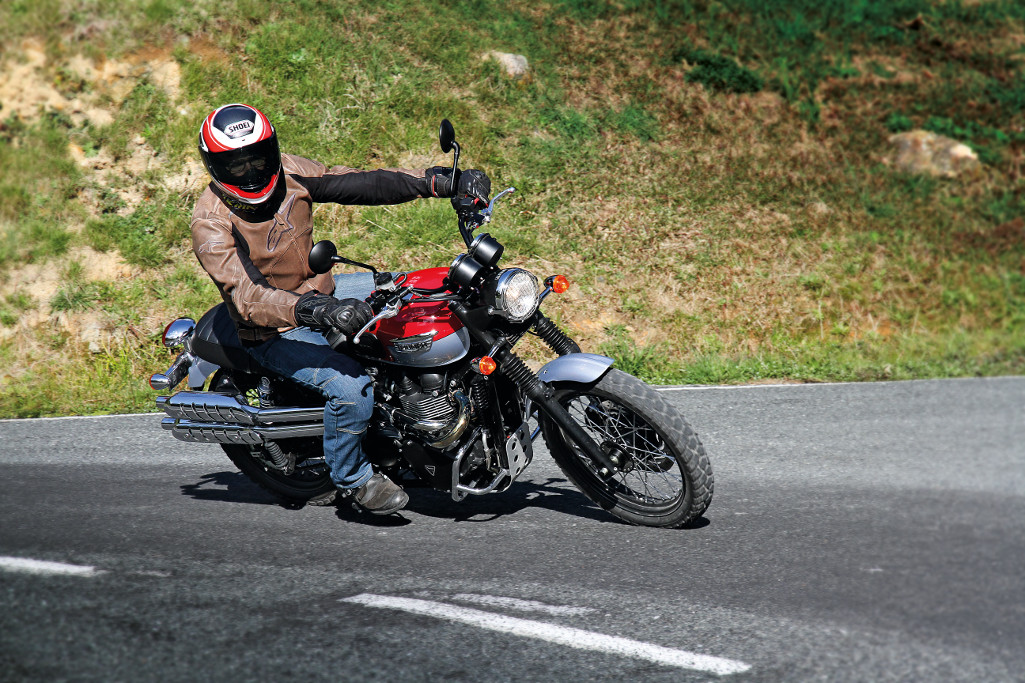 The sound is a perfect fit for the look: rock-solid and timeless and it does get people’s attention, sounding like something Mr. Winkler would have ridden as ‘The Fonz’ in Happy Days. I tried unsticking the garage door after looking over my shoulder at the Triumph Scrambler – surely a well-placed thump would do the trick? Nursing a sore hand as I freed the offending portal, I was hoping the rest of the charm worked better.
The sound is a perfect fit for the look: rock-solid and timeless and it does get people’s attention, sounding like something Mr. Winkler would have ridden as ‘The Fonz’ in Happy Days. I tried unsticking the garage door after looking over my shoulder at the Triumph Scrambler – surely a well-placed thump would do the trick? Nursing a sore hand as I freed the offending portal, I was hoping the rest of the charm worked better.
The exhaust has to have been designed by a rider who habitually puts his or her left boot down, as the exhaust does deflect your straightened right thigh a bit at the lights. Fortunately, the shrouding heat shields avoided the sharp burning associated with the up-pipes of the ‘good old days’ and once rolling, all was fine. On the downside, it does get in the way if you give it the ‘scramble’ message on gravel. You need to cock one leg out when you’re up on the pegs and you can’t grip the flanks of the bike effectively, or evenly with your inner calf zone, when sliding, so serious gravel play isn’t going to win the pipe any friends. Also, the underslung rear brake calliper and exposed brake line whispers adventure rather than openly stating any such intentions. It’s the price you pay for the look. But, really, that’s a pretty good trade. Adding to the vintage scrambler theme is a classy little front guard, cut in the classic form of the Sixties hot-rod style and the cool mock carbies, complete with ‘choke’ lever. It is used as a fast idle switch to help the slightly cold-blooded nature of any air-cooled engine first thing in the morning..
Scrambler… really?
 Yep.
Yep.
With the spoked wheels and trendy soft-road tread pattern, it’s a great looking motorcycle, even if it isn’t your thing. The blending of T100 parts makes sense; and although it looks quite different, that’s where all the base components bar the crankshaft, footpegs and handlebars come from. From there, it’s all about styling. Looking back through the mists of time, that’s exactly what the original scramblers were. The collectable Triumph Trophy series were used in scrambles, trials and road events. With the modifications back then being upswept exhausts, short alloy guards and wide ‘bars, the new Scrambler is looking more authentic all the time. With the sport of scrambling being natural terrain and jumps considered mere bumps by modern dirt bikes, the quintessential description of the original ‘Scrambler’ is reflected surprisingly accurately by the Triumph. The old legends would have raced it in paddocks. Now, we have more suitable options, so the modern Scramblers, from all the brands, are hardly likely to get airborne when off-road. It’s nice to feel like you could, though… for back road exploring, complete with gravel, the low C-of-G and mild and nicely metered power makes the Scrambler happily burble anywhere you ask. On the seal, it’s a satisfying and relaxed ride, as you’d expect with the modest power figures rendering the total absence of electronic intervention quite in keeping. With the single disc, ABS is not hugely missed, but it’ll no doubt be added next year. If you struggle with the lack traction control on the solidly built and mild-mannered Triumph Scrambler, you’re doing it wrong… tyre shredding is not what this cool retro is about. But, then, it’ll still top the ‘ton’.
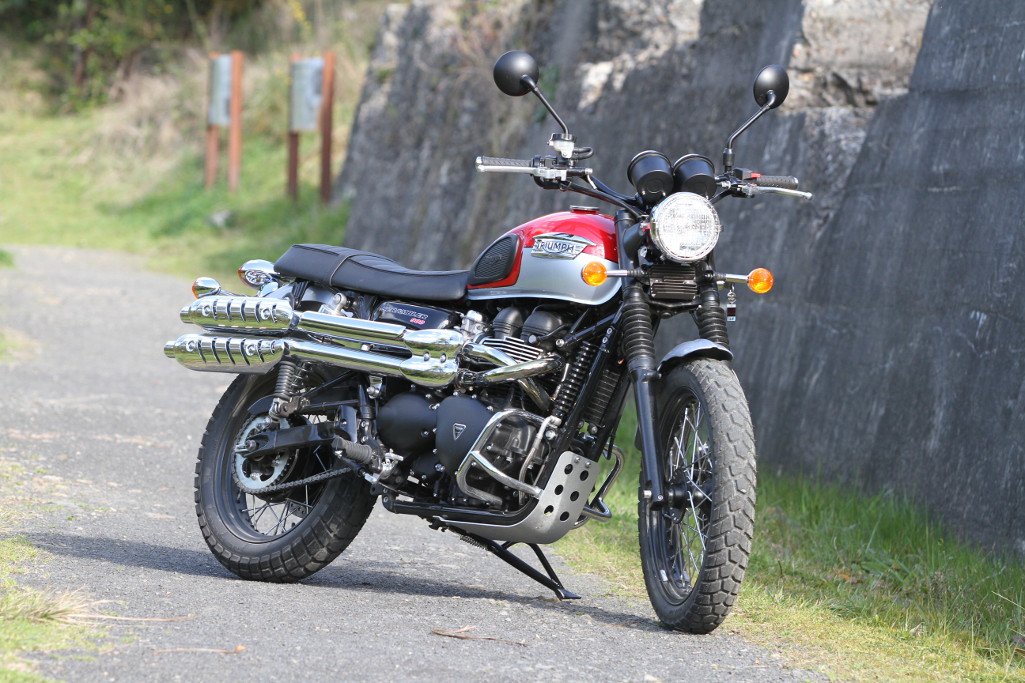 What makes it different from the T100-based T214 we had in BRM a couple of months back? Sound and attitude; and that’s enough for people to covet one over the other. The taller seat height is as much to do with thicker foam as the small increase in suspension movement from a regular Bonnie but that does give it a suppler ride. For traversing the metropolis (maybe not Paeroa as it’d be over too soon) the Scrambler is ideal with its broad spread of torque helping the barely sixty horses propel you in comfort and undeniable style. The reconfigured engine makes its maximum torque and slightly reduced maximum power lower down the rev-range than the ‘road bike’ versions, so possibly even more tractable in town. If you need serious speed to feel cool, you won’t gel with the Scrambler – but the Scrambler is undeniably cool in its own way anyhow.
What makes it different from the T100-based T214 we had in BRM a couple of months back? Sound and attitude; and that’s enough for people to covet one over the other. The taller seat height is as much to do with thicker foam as the small increase in suspension movement from a regular Bonnie but that does give it a suppler ride. For traversing the metropolis (maybe not Paeroa as it’d be over too soon) the Scrambler is ideal with its broad spread of torque helping the barely sixty horses propel you in comfort and undeniable style. The reconfigured engine makes its maximum torque and slightly reduced maximum power lower down the rev-range than the ‘road bike’ versions, so possibly even more tractable in town. If you need serious speed to feel cool, you won’t gel with the Scrambler – but the Scrambler is undeniably cool in its own way anyhow.
Triumph Scrambler
Price: $15,490
Engine: Air-cooled DOHC parallel twin, 270degree firing interval
Displacement: 865cc
Bore and stroke: 90 x 68mm
Compression: 9.2:1
Fuel system: Multipoint sequential fuel injection in mock carburettor bodies
Maximum power: 59ps @ 7000rpm
Maximum torque: 68Nm @ 4750rpm
Exhaust: High-level stainless steel headers with chromed silencers
Gearbox: 5-speed
Frame: Tubular steel cradle type
Front wheel: 36-spoke 19 x 2.5”
Rear wheel: 40-spoke 17 x 3.5”
Front tyre: 100/90 R19
Rear tyre: 130/80 R17
Front suspension: Kayaba 41mm forks, 120mm travel
Rear suspension: Kayaba chromed shocks with preload adjustment, 106mm travel

